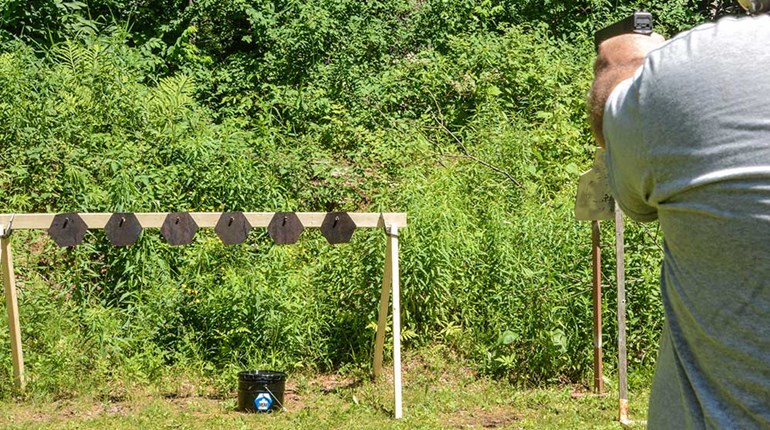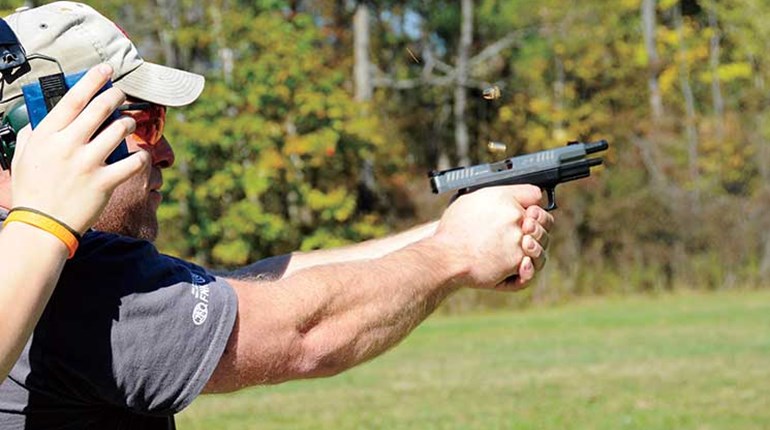The ear-splitting shriek was accompanied by a rhythm section of breaking branches and thudding feet. The dust filling the air was back-lit by a bright morning sun until it formed an opaque curtain that was difficult to see through. Inside, a giant, barely formed shape was moving fast in our direction as I adjusted the grip on my double rifle, which now seemed oddly petite in my hands. I wondered, not for the first time, how we managed to stumble so close to elephants without seeing them.
The professional hunter had mentioned just a few hours before that the elephants on this ranch had bad attitudes; he hoped we would finish the safari without the need to shoot one in self-defense. At this moment I was certain he was psychic.
When you are tracking a herd of buffalo and getting close all senses are set to high anyway, so with the pump already primed, the shock of this sudden charge sent a jolt of adrenaline into my system like a case of guzzled Red Bull. They call it the “fight-or-flight response,” but there was no flight; you can’t outrun an elephant that’s this close. So I stood my ground, ready to shoot and wishing I had solids in both barrels.
The bull smashed through the last of the trees and skidded to a stop yards in front of us, throwing more dust into the air.
“He is charging the buffalo,” said one of the trackers in his soft, musical, African voice.
But the buffalo were not backing down. The small herd of bulls stood like a defiant street gang, staring down the elephant. The bull kicked dust, stomped his feet and continued to shriek like a banshee at a rock concert with an amplifier cranked to 10.
That’s when we decided we were not really all that interested in shooting any of these buffalo. We slowly backed out of there, making ourselves very small and being very quiet.
“I told you these elephant all have an attitude, didn’t I?” the PH said once we were a safe distance away. “Those buffalo got too close and that bull didn’t like it. What you heard was elephant talk for ‘get off my lawn.’
“Actually that was a good thing. We didn’t know the elephants were there and that young bull might have done worse to us if we had stumbled in much closer.”
That’s a lot of excitement for a leopard hunt, don’t you think?
You may have read about my last leopard hunt in American Hunter a few years ago. What you didn’t read about was all of the problems, and there were many.
The final one happened on U.S. soil. I shot the leopard in 2009, but it was shipped to the United States with a 2010 CITES tag attached to the skin. The United States Fish and Wildlife Service seized the leopard because the tag didn’t match the paperwork. I hired a lawyer, fought it and lost. We even received a letter from the Zimbabwe government stating it was a legally hunted leopard and that the tag was placed in error. But it didn’t matter. The leopard was seized and, presumably, destroyed.
To atone for his outfit’s mistake, Alistair Pole at Zambezi Hunters offered me a deal on another leopard hunt. Buffalo hunting was a last-minute add on, one that saved the safari, as it turned out, because adult male leopards were as common as dinosaur eggs on the property we hunted.
I knew that once the baits are in place leopard hunting is mostly a game of waiting for something to happen. That leaves a lot of open time on a safari, time most hunters use to hunt other species. So, for an additional fee, I added sable and Cape buffalo.
I will always pick the buffalo option if it’s available, because when properly hunted, a Cape buffalo is perhaps the most exciting and challenging animal on earth.
By “properly hunted” I am talking about tracking the buffalo and hunting on foot in his domain. Riding around in a safari truck and shooting a bull is cheating yourself.
I have only hunted buffalo in the brush and can’t comment on what it’s like to hunt them in open country where you may shoot 200 yards. But, for me, it’s about getting close, working the thick mopane or jess, with the anticipation that every step can reveal the buffalo.
The excitement and challenge is in “walking miles and miles of bloody Africa” while following buffalo tracks. It’s in working around the herds of buffalo, trying not to be noticed by the multitudes of eyes, ears and noses as you search for that one trophy bull.
Or it might be following a group of dugga boys to its daytime haunts and trying to find the right one without any of those grumpy old men taking notice. It’s slipping and sliding, creeping and crawling until you are so close you can smell their breath. That’s the excitement, the soul and the life of buffalo hunting.
The essence of buffalo hunting can be found in those moments when you suddenly realize you are breathing again and you can’t remember how long you weren’t; when you get lost in time as you find yourself so close you can count the ticks on his back; when nothing else exists except for you, Africa and buffalo. That’s what makes buffalo hunting so damn special. If there is any other hunting on earth like this, it has escaped my notice.
Cape buffalo are of course one of the big five and are considered to be a premier dangerous-game animal to hunt. They are a bit unique in that category, for reasons I think make them even more exciting.
Buffalo have for eons been considered food by lions and other predators so, like most prey, they are extremely wary. But unlike the other “eyes-on-the-side-of-the-head” critters, buffalo don’t resign to their prey status with a passive acceptance. Most “food” critters accept their fate and offer little resistance other than trying to run away. When is the last time you saw an impala kick a leopard’s butt on the “Animal Planet” channel? Prey animals are born to die and most are genetically programmed to accept that once they are caught. But not buffalo. A calf might not put up much of a fight, but any grown-up buffalo is going to make some mayhem before it dies. Rather than passively accepting death, buffalo have an attitude unlike any other prey: They are going to beat the hell out of any threat.
Dangerous-game animals are often the large predators, and hunting predators is different. We once were just another food source for them. Lions, tigers and bears (“oh my,” sorry) are equipped to kill, and for eons they saw humans as easy targets.
It’s said that our drive to hunt these large predators has its foundations buried deep inside our lizard brains, probably left over from when we were a food source. Sociologists tell us that once we learned to hunt, rather than be hunted, man progressed and evolved. Among other things, it was man’s ability to use tools to fight, kill and dominate the large predators that distinguished us from other “food sources.” This allowed us to spend less time avoiding being entrées and more time building cities, spaceships and hospitals. But some of that dark history stayed behind, locked deep in the subconscious of our minds where it manifests itself in a desire to hunt large predators.
The drive to hunt dangerous game in general may be built on a slightly different foundation, as it includes animals that are not predators. Most experienced African hunters will tell you that the most dangerous game is those prey animals with the ability to fight back. Almost without dissension those with a lot of African experience pick the elephant or the buffalo as the most dangerous game to hunt. Oddly enough, neither is a predator.
Once they are full grown, for the most part man is their primary predator and that seems to tick them off. We are puny, weak and easily crushed, and at times elephants and buffalo will attempt to do exactly that. All too often they succeed, which makes them very exciting to hunt.
The trouble with elephant hunting is that it’s very expensive and short on opportunity, so most hunters, if they are lucky, are one and done. It’s the same with many of the large predators. Lions and big bears are very expensive to hunt, tigers are impossible. Plus, for a lot of hunters, one and done is enough with the large carnivores. Again, I think it’s a lizard brain thing. Once we succeed, the need abates.
Buffalo are prey animals and they evoke a much different emotional response than predators. They are also more common, even abundant, so hunting them is far less brutal to the checkbook than other dangerous-game hunting.
I was recently asked, “Just how many times do you need to hunt buffalo?” My reply: “At least once more.” I never tire of it, and with buffalo I don’t endure the lingering guilt that hunting carnivores sometimes instills.
Buffalo are big, tough and often grumpy. If you are hunting them, they might take offense and be quick to pick a fight. They say a buffalo won’t attack a hunter unless he is provoked. But who knows what will do that? It may be because a poacher’s homemade bullet is stuck in his guts and he is hurting, or maybe it’s just because you are occupying the same planet and he doesn’t like it. When it comes to buffalo, “provocation” is a fluid concept.
I was hunting buffalo this time on the Save Conservancy in southeastern Zimbabwe, on a government-owned property called ARDA. It’s not exactly the mythical, J.R.R. Tolkien lands of the same name, although at times it seemed so exotic it could be. In Zimbabwe, ARDA stands for “Agricultural and Rural Development Authority.”
Zimbabwe is run by a dictator named Robert Mugabe. His administration has a talent for finding anything productive in that country and bleeding it dry. In a shocking display of racism, they took away farm lands that had been in families for generations simply because the owners were white, even properties with clear deeds. All of it was approved by Mugabe himself. This “forced redistribution” resulted in a once thriving, farm-based economy turning to total collapse. It got so bad that Zimbabwe, a country with a currency once comparable to the U.S. dollar, hit an inflation rate of 471 billion percent in 2008. Now, they no longer even have a currency. So it’s not like Mugabe has much of a track record for making anything work except graft and corruption.
Lately, Mugabe’s guys are noticing the safari industry. In the Save Conservancy, they refused to give wildlife harvest permits for most of the privately held lands unless the safari companies turned over controlling interests to their hunting companies to hand-picked, Mugabe-controlled Africans. Those ranch owners with strong political connections and of course the government-owned lands had little trouble receiving quotas and permits, including ARDA.
ARDA is a small property, and with the exception of elephants and buffalo, which were both in abundance, it held a lot less game than the private Sango Ranch I hunted in 2009. Even though they are both part of the Save Conservancy and the distance between them is only a few miles, the hunting quality differed greatly.
Some of that was due to poaching, as we found plenty of evidence, including snares, every day. I had to shoot a giraffe that had been in a snare and was near death. Another party encountered an elephant in the same situation and had to put it down. One day we even caught some poachers in the act. They were later turned loose by the “authorities,” which explains the continuing problems. But, as I would later learn, the property was also being over-hunted.
At first I was seeing a lot of buffalo. We estimated one herd held more than 600 animals, and that was only one of several herds on the property when my safari started.
It was closing in on evening and we had just a few more minutes of shooting light. We could see the dust from the herd and knew we were very close. As we approached the edge of an open area we climbed a high termite mound for elevation. What I witnessed was a spectacular sight and one I’ll remember to the grave. (I am fortunate to have several of those vivid outdoor memories that will last forever; it seems that buffalo hunting has contributed an inequitable number of them.) In front of me, for as far as the eye could see right or left, was a solid wall of buffalo. It was as if somebody had built the Great Wall of Africa using buffalo for bricks. We stayed there and watched and as the light receded they merged into a solid black line and then faded into the night.
We were into buffalo on every hunt, so I was in no hurry to shoot. I wanted to know that I had truly hunted buffalo before I pulled the trigger. I wanted a few of those moments when it’s so hard to breathe. I wanted blisters and thorns; I wanted to sweat and hurt and to experience the highs and lows of buffalo hunting. So, waiting didn’t bother me. There were a lot of good bulls and we had seen an exceptional bull twice. We got close both times, but I never could quite close the deal with him. Still, I decided he was my standard. I wanted this bull or one of his equal.
I was having a good time so I wasn’t worried. But perhaps I should have been. This was a small property, well suited to a single small safari. But, with the troubles attaining permits and many other properties shut down, there were three safaris on ARDA while I was there. It was too much.
Soon after the third safari group joined us, the elephants disappeared. Most of the other game left the property as well. We were no longer seeing many zebra, kudu, impala, eland or much of anything else. We never found even the track of an adult male leopard, and the few sables on the property disappeared. Each day our buffalo sightings grew fewer and fewer, and the big bulls seemed to vanish.
But we stayed with it, often tracking buffalo to the border of the property and the bitter disappointment of turning back unfulfilled. On the 12th day, close to noon, we found that big bull, mostly by accident. I won’t lie, I muffed a tricky shot and he ran off wounded. It was another first for me.
We tracked him to his bed just a few hundred yards away. He rose and stood staring at us as if he was working out his own fight-or-flight decisions. The PH hissed to me not to shoot until he was sure it was the right bull. There was no time to debate: We had followed a blood trail right to this one, so I stood and held that heavy double rifle at the ready as my arms began quivering with fatigue. Only after the bull turned to run did I get the OK to shoot. I hit him again, but not well.
I’ll probably be criticized for saying this, but the next hour spent tracking that wounded buffalo in the thick brush was the most exciting thing I have ever done. I loved every minute of it. It was an aspect of buffalo hunting I had never before experienced. It’s impossible to describe my range of emotions.
Shooting is what I do, so when it goes poorly I am my toughest critic. I beat myself up even after a good shot, always thinking it could be better. With a bad shot such as that first one, I am merciless; at that moment I was sadistically nasty. I was sick, partly for wounding the animal, though I had no doubt we would get it, but mostly because of what I took as a personal failure. Nobody else in the world could ever treat me the way I treat myself in these situations. But, at the same time, it was thrilling to be tracking the most dangerous game on earth, a wounded Cape buffalo. I had no doubt my shooting would be up to the task when the time came.
The end was rather anticlimactic. I suppose I could tell you the bull charged and the hero stopped him with his last shot, so close the buff knocked the empty rifle from the hunter’s hands as he fell. But it wasn’t like that. We jumped him a few more times, I got a few more bullets in him and finally he just stopped and waited for the last one to arrive.
It was an odd kind of safari. Not at all what was promised or expected. There was no leopard, no sable. There was nothing except this buffalo. But in the end, it was enough.





































